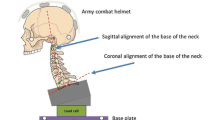Summary
Motion analysis of the cervical spine is a sensitive tool in the fields of preventive and clinical biomechanics of whiplash. In the field of preventive biomechanics motion analysis contributes to validation and optimisation of dummy based crash test experiments and simulations. In the clinical field motion analysis up to now is of restricted value. Data exist about restrictions and pathologies of movement and motion of the cervical spine, coordinative disturbances, postural control, TMJ-function and oculomotor disturbances after whiplash. The standardisation of technical and clinical set-ups is necessary to establish a well proven biomechnical model of whiplash and whiplash related biomechanical dysfunction. Without this model the value of motion analysis for clinical use will be restricted due to lack of comparable data on sensitivity and specificity although motion analysis of the cervical spine is neither cost- nor time consuming and free of adverse effects. Within a prospective series of 28 patients (14 m/ 14 f) with a follow-up to six weeks we were lucky to describe numerically two different types of reaction to low energy (Δv < 20 km/h) rear end collision: Type I with disturbances in complex movements only, Type II with overall restriction of movement. Control of angular velocity during cyclic movements of the head was disturbed by oscillations of higher frequency in all patients. Recovery from whiplash within 6 weeks could be monitored.
Zusammenfassung
Die Bewegungsanalyse der Halswirbelsäule (HWS) ist ein sensitives Verfahren der präventiven und klinischen Biomechanik des „Schleudertraumas“. In der präventiven Biomechanik ist es möglich, mit Hilfe der Bewegunganalyse die Biofidelität von Dummy-Versuchen zu verifizieren und zu verbessern. Die klinische Bewegungsanalyse bietet nach wie vor ein uneinheitliches Bild. Meßdaten liegen über Einschränkungen der HWS-Beweglichkeit, Koordinationsstörungen, Gleichgewichtsstörungen, Kiefergelenkfunktion sowie Störungen der Okulomotorik nach Beschleunigungstrauma vor. Eine Vereinheitlichung der technischen und klinischen Untersuchungsbedingungen ist erforderlich, um ein geeignetes biomechanisches Modell des posttraumatischen Zervikalsyndroms [19] zu etablieren. Ohne dieses Modell ist die Bedeutung der Bewegungsanalyse beschränkt, da klinische Sensitivät und Spezifität der Messung empirisch nicht sicher ermittelt werden können.
Similar content being viewed by others
Author information
Authors and Affiliations
Rights and permissions
About this article
Cite this article
Bär, H., Witte, H., Pape, H. et al. Motion analysis in the context of “whiplash”. Orthopäde 27, 827–833 (1998). https://doi.org/10.1007/PL00003470
Published:
Issue Date:
DOI: https://doi.org/10.1007/PL00003470




